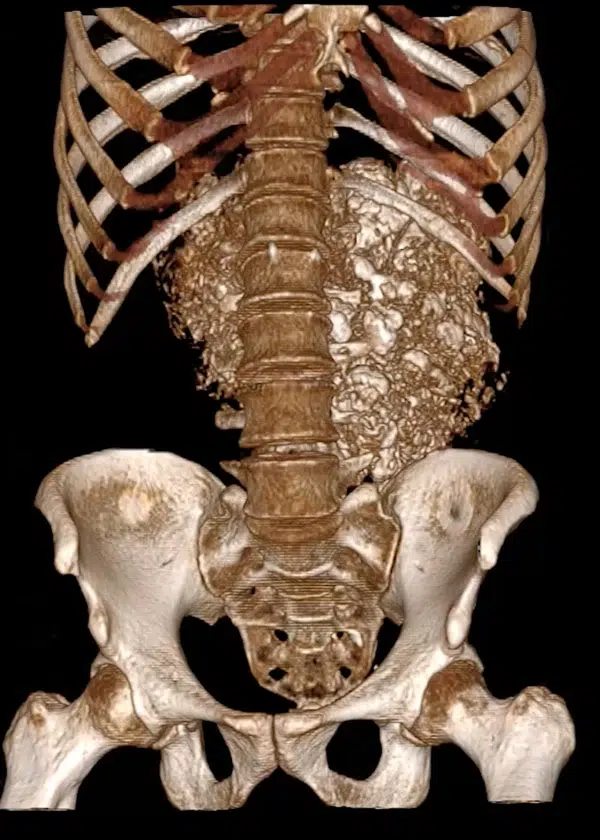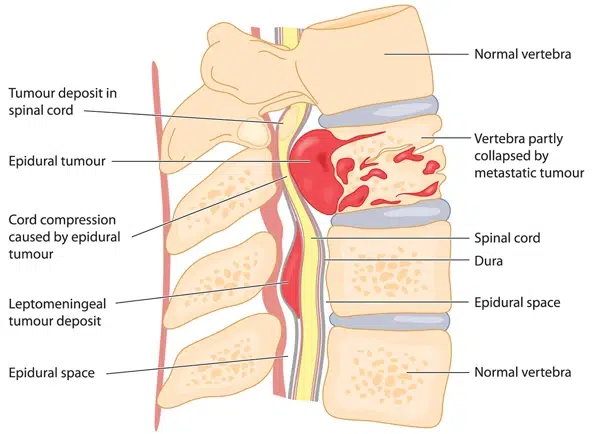What is the spinal tumor?
A spinal tumor is an abnormal growth developing either in or around the spinal column, spinal cord, or spinal nerves.
What is the structure of the human spine?

The human spine or spinal column is composed of 33-34 vertebral bones staying on top of each other. In the sacrum and coccyx, vertebrae are fused together, but in other parts, they are connected by joints. The spinal cord is located inside the spinal column and is surrounded by strong bones and ligaments. Therefore, the spine has two main functions: providing protection for the spinal cord and supporting the body weight. The spinal cord connects the brain with the rest of the body by many nerves coming out of it and traveling to all parts of the body.
How does the tumor develop in the spine?
The tumor is an abnormal growth caused by a genetic mutation. All the cells in the human body have a very peculiar genetic system for controlling growth and differentiation. Loss of this control causes cells to divide uncontrollably and cause tumors. Traditionally, tumors can be divided into two main groups: benign and malignant. Benign tumors grow from “inside”. They are basically abnormally expanding structure that pushes nearby structures as it grows. They develop well-defined borders from normal tissue, and thus, surgical removal is relatively easy. Total tumor removal usually provides a cure for these patients.

Malignant tumors, on the other hand, are invasive. Tumor cells dislodge from the original location and invade nearby tissues. Therefore, the border between the tumor and normal tissue is poorly defined. Complete surgical elimination must include the removal of some normal tissue around the tumor, which may lead to loss of function. Malignant tumors may spread to surrounding tissue via direct invasion. Also, they may use lymphatic and blood vessels. This condition is called metastasis. Metastasis is very difficult to treat since surgery and radiation are of limited use.
What are the types of spinal tumors?
Spinal tumors may arise either from the spinal cord and nerves or the spinal column. The spinal cord and nerves consist of nervous tissue, and therefore, tumors arising from them belong to neural lineage. The spinal column, on the other hand, is composed of bone and connective tissue. Thus, tumors arising from it belong to bone/connective tissue lineage and have completely different biological features.
Tumors arising from neural tissue are usually benign and may originate from the spinal cord itself, spinal nerves, or covers. Tumors located outside of the spinal cord are called extramedullary. They are generally easier to remove than tumors located inside of the spinal cord – intramedullary. For example, meningiomas are benign tumors originating from the spinal cord cover. They are extramedullary, benign, slowly growing tumors compressing the spinal cord from the outside. On the other hand, benign tumors like ependymomas and astrocytomas originate from the spinal cord itself (intramedullary) and, therefore, are more difficult to separate and remove.
The spinal cord and nerves are covered by a protective cover named dura mater. Tumors may be located inside this envelope or outside it. Therefore, tumors can be either extradural – outside the covers or intradural – inside the cover. Meningioma, for example, is located inside the cover and therefore is intradural. Schwannomas and neurofibromas are benign tumors originating from the spinal nerves. If the tumor arises from the section of the nerve outside the cover, it is called extradural. Schwannomas may be intradural or intra/extradural depending on the size and location. Sometimes, they have a dumbbell shape with two sections representing intra- and extradural sections. Malignant tumors can also affect the spinal cord and the nerves, but they are very rare.
Spinal column tumors arise from the vertebral bones. These tumors are classified into two main groups: primary and metastatic. Primary bone tumors develop from the bone or connective tissue comprising the spinal column. They can have benign, malignant, or mixed behavior.
Primary bone tumors
Benign tumors
Hemangioma – the most frequent bone lesion in the spine. In the vast majority of cases, it is located inside the vertebral body and does not cause any symptoms. Rarely, it can lead to bone destruction with collapse or may extend into the spinal canal, compromising the spinal cord and/or the spinal nerves.
Osteoid osteoma and osteoblastoma– are identical tumors, but osteoid osteomas are small (less than 1 cm). If the tumor is more than 1 cm, it is called osteoblastoma.
Osteochondroma or enchondroma – benign tumors originating from cartilage tissue in the spine
Aneurysmal bone cysts – are considered benign tumors; however, they tend to recur after incomplete removal.
Malignant tumors
Osteosarcoma – the most frequent primary malignant bone tumor of the spine. Surgical removal is the cornerstone of the treatment. The best results are achieved with total removal since residuals (tumor leftovers) are resistant to chemotherapy and radiation treatment.
Chondrosarcoma – is also a malignant tumor originating from cartilageous tissue. Like osteosarcoma, it is resistant to chemo- and radiotherapy and surgical removal are the main treatment options.
Multiple myeloma and solitary plasmacytoma– are tumors arising from the bone marrow. They are the same tumors, but plasmacytoma occurs in one location. If the tumor is encountered in many locations, it is called multiple myeloma. Usually, these tumors are treated with chemotherapy and radiation. Surgery is reserved only for cases when bone fracture is present, causing instability or spinal cord compression is evident.
Metastatic bone tumors

Metastatic tumors, on the other hand, are extensions of other cancers into the bones. They comprise the vast majority of spine tumors. Technically, bone metastases occur in the bone marrow rather than in the bone tissue itself. Since the spine contains almost a third of the total body bone marrow, it is the most frequent bone metastasis site. Cancer cells dislodge from the main tumor site and are spread to the spine by blood flow. This process is called hematogenous metastasis. In some cases, the main tumor does not produce symptoms, and the tumor is first discovered in the spine.
Metastatic tumors can cause destruction of the tumor (osteolytic) or promote bone formation (osteoblastic). In some cases, tumors may have both osteolytic and osteoblastic features. Generally, osteolytic tumors are more dangerous since they weaken the bone and cause fractures.

What are the symptoms of spinal tumors?

The most common symptom of spine tumors is pain. The pain is usually located at the involved site but may radiate to different parts of the body if nerves and the spinal cord are involved. Pain may be very significant if the tumor is causing bone destruction and fracture. This type of fracture is called pathological and may cause excruciating pain.
A neurological deficit may be present if tumors of fractured bone parts compress the spinal cord and nerves. Usually, patients develop numbness, weakness (paralysis), ataxia (loss of balance), and inability to control bowel movements and urination.
How is the spinal cord tumor diagnosed?

Diagnostic evaluation starts with a thorough history and physical evaluation. It provides important information about the possibility of cancer, like weight loss or smoking habits. Assessing neurological status is very important since the patient may not be aware of the ongoing neurological deficit or may think that it is irrelevant.
Spine imaging is a key element in diagnostic work-up. Magnetic resonance imaging (MRI) of the spine with intravenous contrast is the most preferred modality. It is usually sufficient to demonstrate the presence and extent of the tumor as well as its relationship with the spinal cord and nerves. Computerized tomography (CT) and X-rays can show bone structures better than MRI.
For patients with suspected metastasis, positron emission tomography (PET) can demonstrate the main tumor as well as other metastasis if present. Lab tests with tumor markers may be necessary to assess the extent of the tumor. In some cases, a biopsy from an easily reachable area can be performed in order to establish the diagnosis.
What is the treatment of the spinal cord tumor?

Management of spinal tumors is highly specific. The most important aspect is the pathological diagnosis of the tumor. In some cases, the diagnosis is very straightforward, and the treatment is well-known. In other cases, extensive work-up may be required to reveal the nature of the tumor.
There are three options available for the treatment: surgery, chemotherapy, and radiation therapy. The choice of treatment depends on the sensitivity of the tumor to chemo- and radiotherapy and the feasibility of surgical removal.
Primary spinal cord and bone tumors are usually treated with surgery. It allows the removal of the mass effect, obtaining tissue for pathological diagnosis, and providing stability to the spine if needed. Completely removed benign tumors do not require further therapy. Malignant tumors may require adjuvant chemo and radiation treatment following the surgery. Surgical removal may be very challenging since the tumors may be hard to separate from the spinal cord and nerves. Therefore, it should be performed by an experienced surgeon.
Management of metastatic tumors depends on the type and stage of the tumor. Although these patients were once considered inoperable and terminal, modern therapeutic modalities now allow most of them to undergo surgery, with adjuvant chemo and radiation therapy. The goal of surgery is to relieve the pressure from the spinal cord and nerves and provide stability to the spine if compromised.
